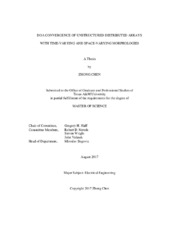| dc.contributor.advisor | Huff, Gregory H. | |
| dc.creator | Chen, Zhong | |
| dc.date.accessioned | 2018-02-05T21:21:41Z | |
| dc.date.available | 2019-08-01T06:51:43Z | |
| dc.date.created | 2017-08 | |
| dc.date.issued | 2017-08-04 | |
| dc.date.submitted | August 2017 | |
| dc.identifier.uri | https://hdl.handle.net/1969.1/166051 | |
| dc.description.abstract | This thesis mainly focuses on the research of the factors that influence the accuracy and efficiency of a UAV-based radio frequency (RF) and microwave data collection system. Swarming UAVs can be utilized to create the unstructured morphing antenna arrays that reduce aliasing and improve convergence in sub-space direction of arrival techniques.
This thesis first reports on the ramifications of using unstructured antenna arrays based on sub-space techniques. This work evaluates the classical MUSIC algorithm and root-MUSIC algorithm, and Fourier domain root-MUSIC algorithm (FD Root-MUSIC). Compared to the MUSIC algorithm, the root-MUSIC algorithm avoids the search of spatial spectrum, reduces the computational complexity and improves the ability of real world applications.
Then, this thesis comes up with the data model for the UAV swarming system. Based on the data model, this work examines the impact of UAV swarm density and heterogeneity on synthetic aperture DOA convergence. The synthetic aperture is derived from the displacement of distributed UAVs operating in a sparse volumetric swarm. Heterogeneity arises from the changing orientation of a UAV’s antenna and receiving pattern function as it swarms in the distributed cluster of UAVs. This alters the UAVs’ antenna pattern functions over time and alters the convergence and overall performance properties of vector-space direction of arrival techniques. This work evaluates the impact of the swarm density and orientation in this framework and studies the convergence and error using MUSIC algorithm. This work also discusses the impact of different type of errors introduced from UAV swarming.
Furthermore, this thesis examines the DOA convergence performance of location-varying volumetric random array using MUSIC algorithm. Simulation and measurements for up to sixteen elements on a thirty-two-location test platform are provided and comparisons are made to benchmark their performance with theoretical expectations. MATLAB simulation indicates that the volumetric random arrays can be applied in a very noisy condition by increasing the iterations and multiplying the MUSIC spectrum and experimental observations demonstrate that the system accurately capture the azimuthal and elevation angles of the source.
At last, this thesis investigates and designs the tunable FM band monopole and loop antennas to locate the FM broadcasting stations. The wavelength of the FM band is around three meters. This work uses lumped elements and meandering antenna structure technologies to reduce the antenna size and match the antenna. This work also uses the varactor diodes to tune the antenna. However, the antenna becomes electrically small and the antenna gain is so low that it cannot detect the FM signal from the local FM broadcasting stations. | en |
| dc.format.mimetype | application/pdf | |
| dc.language.iso | en | |
| dc.subject | Direction-of-arrival estimation | en |
| dc.subject | Unmanned aerial vehicles | en |
| dc.subject | Quaternions | en |
| dc.subject | Swarming | en |
| dc.subject | Aperiodic arrays | en |
| dc.subject | MUSIC algorithm | en |
| dc.title | DOA Convergence of Unstructured Distributed Arrays with Time-varying and Space-varying Morphologies | en |
| dc.type | Thesis | en |
| thesis.degree.department | Electrical and Computer Engineering | en |
| thesis.degree.discipline | Electrical Engineering | en |
| thesis.degree.grantor | Texas A & M University | en |
| thesis.degree.name | Master of Science | en |
| thesis.degree.level | Masters | en |
| dc.contributor.committeeMember | Nevels, Robert | |
| dc.contributor.committeeMember | Wright, Steven M. | |
| dc.contributor.committeeMember | Valasek, John | |
| dc.type.material | text | en |
| dc.date.updated | 2018-02-05T21:21:42Z | |
| local.embargo.terms | 2019-08-01 | |
| local.etdauthor.orcid | 0000-0002-2635-1015 | |


